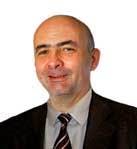Quality, not commodity with Veolia Water
by Carlos David Mogollón, Managing Editor
Sustained high fuel prices have helped the bottom lines of more than just oil & gas companies. The push to take advantage of higher prices by tapping into broader reserves around the world has created additional business for water and wastewater companies as well, according to Veolia Water executives interviewed at WEFTEC.06 in Dallas.
“Everybody is trying to get oil out of the ground now and with that comes a lot of water that has to be separated and treated. There’s a lot of business for us in the oil & gas fields with produced water treatment. There are a lot of refinery applications as well,” said Finn M. Nielsen, president of Veolia Water Systems North America.
Even older less productive wells or wells with higher volumes of produced water, water that comes up along with oil & gas extraction, are being revisited because current economics makes them more profitable. And tougher extraction methods such as from oil sands are booming, particularly in Alberta, Canada.
Jean-Michel Herrewyn, executive vice president and CEO of Veolia Water Solutions & Technologies, noted oil sands extraction technology requires a lot of steam, which requires boiler water treatment, heat exchange and zero liquid discharge technologies for reuse.
“It’s not just oil prices that are attracting people,” Herrewn said. “It is more important than that. It’s taking an economical, kind of environmental approach in the extraction; and then, with the water, the same aspect associated with its utilization, disposal or reuse. It’s a kind of cycle for us, because we need more complex technologies to separate the oil from water.”
The French-based company, with 2005 revenues of $10.7 billion (of which the Americas account for 7%), focuses on water and wastewater service outsourcing contracts, targeting largely industrial clients in North America, Herrewyn added. It has five companies here: Kruger Inc., John Meunier Inc., HPD and Whittier Filtration. Mining, power generation and food & beverage markets also have been hot industries for it.
The trick, note both Herrewyn and Nielsen, is to be able to find a technology or service specialty area such as evaporation and crystallization strengths at HPD or Actiflo and NEOSEP MBR, which just gained California Title 22 approval, technology at Kruger to differentiate your company. In that manner, you’re competing with quality, not a commodity. Click here to read: "Q&A: An Interview with Veolia Water's Herrewyn & Nielsen" in full.


